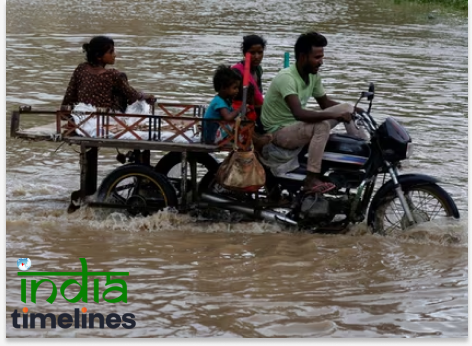
Heavy rainfall in Gujarat has resulted in severe flooding across multiple districts, causing widespread devastation and loss of life. As of now, 28 people have been confirmed dead, and approximately 17,800 individuals have been evacuated from their homes. This article provides live updates on the situation, the impact on local communities, rescue efforts, and future steps to manage such disasters.
Overview of the Flood Situation in Gujarat
Gujarat, known for its vibrant culture and robust economy, has been hit hard by torrential rains, leading to unprecedented flooding. The state has experienced heavy rainfall over the past few days, causing rivers to overflow and inundate cities, towns, and villages.
Causes of the Floods
The primary cause of the flooding is the monsoon rains, which have been more intense than usual this year. Weather experts suggest that a combination of factors, including climate change, has led to this abnormal increase in rainfall. The incessant downpours have caused several rivers, including the Sabarmati and Tapi, to overflow, leading to flash floods in various regions.
Areas Worst Affected
Districts such as Vadodara, Surat, and Rajkot have been particularly hard-hit, with roads submerged, bridges washed away, and homes destroyed. Low-lying areas are facing the brunt of the disaster, with water levels rising above danger marks.
Impact of the Floods
The flooding has led to significant loss of life and property. The immediate impact on the people of Gujarat has been catastrophic, with entire communities uprooted and relocated to temporary shelters.
Human Casualties and Displacement
The current death toll stands at 28, with hundreds more injured or missing. The government has set up relief camps to accommodate the 17,800 evacuees, providing them with food, water, and medical aid. However, the conditions in these shelters remain challenging due to overcrowding and limited resources.
Infrastructure Damage
Floodwaters have caused severe damage to infrastructure, including roads, bridges, and public buildings. Power outages have been reported in several areas, and communication networks have been disrupted, making rescue operations even more difficult.
Rescue and Relief Operations
The government and local authorities have launched massive rescue and relief operations to save those stranded and provide immediate assistance to affected families.
Government’s Immediate Response
The State Disaster Response Force (SDRF) and National Disaster Response Force (NDRF) have been deployed in full strength. Helicopters and boats are being used to rescue people from rooftops and other flooded areas. Relief materials, including food, drinking water, and medicines, are being distributed to those in need.
Role of Local Authorities and Volunteers
Local authorities, along with volunteers, have been working tirelessly to ensure that relief reaches the most affected areas. Community kitchens have been set up, and temporary shelters are being organized in schools and community centers.
Challenges Faced by Rescue Teams
Despite the swift action, rescue teams are facing significant hurdles in their operations.
Accessibility Issues
Many roads and pathways are blocked due to waterlogging and landslides, making it hard for rescue teams to reach remote areas. Additionally, the strong water currents pose a significant risk to rescue boats.
Weather Conditions
The continuing rainfall and unpredictable weather patterns add another layer of complexity to the rescue efforts. The teams are battling not just floods but also heavy winds and thunderstorms.
Health Concerns Amidst Flooding
Floods bring with them a host of health concerns, which, if not managed properly, could lead to secondary disasters.
Spread of Waterborne Diseases
There is a rising fear of waterborne diseases such as cholera, typhoid, and leptospirosis. Stagnant water becomes a breeding ground for mosquitoes, increasing the risk of malaria and dengue outbreaks.
Access to Clean Water and Sanitation
Providing access to clean drinking water and maintaining hygiene in relief camps is crucial to preventing an outbreak of diseases. Authorities are distributing water purification tablets and setting up temporary medical camps to monitor health conditions.
Impact on Agriculture and Livelihoods
The floods have not only affected lives but also livelihoods, particularly in rural areas.
Damage to Crops and Farmlands
Gujarat’s agricultural sector has suffered massive losses, with crops like cotton, groundnut, and vegetables destroyed across thousands of acres. Farmers are facing huge economic setbacks, with many losing their entire year’s yield.
Effect on Local Economy
The damage to crops and the displacement of people have had a cascading effect on the local economy. Markets have been disrupted, and small businesses are struggling to survive in these conditions.
Stories of Survival and Heroism
Amidst the devastation, there are also stories of courage and resilience.
Acts of Bravery by Locals
Numerous stories have emerged of locals helping each other, from rescuing neighbors to providing food and shelter. These acts of heroism have brought communities closer in these trying times.
Rescues and Relief Efforts
Rescue workers have been putting their lives on the line to save others, often navigating dangerous conditions to reach stranded individuals.
Role of Technology in Rescue Operations
Modern technology is playing a pivotal role in aiding rescue and relief operations.
Use of Drones and GIS for Rescue
Drones are being used for aerial surveys to identify stranded people and assess damage. Geographic Information Systems (GIS) are providing real-time data for effective decision-making.
Real-time Monitoring and Alerts
Weather monitoring systems and flood forecasting tools have been invaluable in predicting flood patterns and issuing timely alerts to residents, helping in minimizing casualties.
Community Support and Solidarity
The flood situation has seen an outpouring of support from within and outside Gujarat.
Support from Neighboring States
States like Maharashtra and Rajasthan have extended support by sending relief materials, rescue teams, and medical aid.
Local Community Initiatives
Local communities have also organized food drives, collection centers for donations, and volunteer-based rescue missions to assist those in need.
Climate Change and Increasing Flood Frequency
Experts have linked the increasing frequency of such extreme weather events to climate change.
How Climate Change is Contributing
Rising temperatures and erratic weather patterns have contributed to more intense monsoons, which in turn cause severe flooding.
Future Projections for Gujarat
If current trends continue, Gujarat is likely to experience more frequent and severe floods. This calls for better planning and preparedness to manage such disasters in the future.
Government’s Long-term Plans for Flood Management
The government is looking at long-term solutions to reduce the impact of such natural calamities.
Infrastructure Upgrades
Plans are in place to strengthen river embankments, improve drainage systems, and build more resilient infrastructure to withstand future floods.
Policy Changes and Investments
Investments are being made in flood forecasting technology, early warning systems, and community awareness programs to prepare the public for any future events.
Role of NGOs and International Aid
Non-Governmental Organizations (NGOs) and international bodies are stepping in to provide much-needed support.
Contributions and Support from NGOs
NGOs are playing a critical role by providing emergency relief supplies, healthcare services, and psychological support to those affected by the floods.
Role of International Organizations
International organizations are providing funds and technical assistance for rescue operations and long-term recovery plans.
Preventive Measures for Future Floods
To avoid such large-scale devastation in the future, proactive measures are needed.
Improved Early Warning Systems
Upgrading early warning systems to provide more accurate and timely alerts can help in better preparedness and evacuation plans.
Community Preparedness Programs
Educating communities about flood risks, safety protocols, and emergency procedures can make a significant difference in minimizing the impact of future floods.
Conclusion
The recent floods in Gujarat have been a harsh reminder of the devastating impact of natural disasters. While immediate rescue and relief operations continue, there is a pressing need for long-term strategies to manage and mitigate such events. Strengthening infrastructure, improving early warning systems, and increasing community preparedness are crucial steps that need to be prioritized. The resilience and solidarity shown by the people of Gujarat in these tough times are commendable, but more needs to be done to prevent future tragedies.
FAQs
- What caused the floods in Gujarat?
The floods in Gujarat were caused by intense monsoon rains leading to overflowing rivers and subsequent inundation of low-lying areas. - How many people have been affected by the floods?
As of now, 28 people have died, and approximately 17,800 have been evacuated from their homes. - What measures are being taken to help the affected people?
The government has launched rescue operations, set up relief camps, and is distributing food, water, and medical supplies. - How can one help the flood victims in Gujarat?
You can help by donating to credible NGOs, volunteering in relief efforts, or supporting community initiatives aimed at providing aid to flood victims. - What is being done to prevent future floods in Gujarat?
The government is investing in infrastructure upgrades, early warning systems, and community preparedness programs to better manage future floods.

































